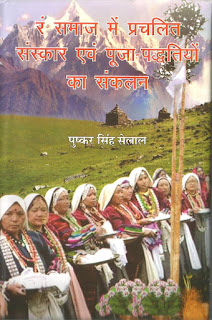 Heritage, traditions, customs and culture - some of the often used words whenever we talk about our rung society - be it at a formal gathering of rung elders or at an informal one over marjya (or more often than not chyakti), cousins chit-chatting after dinner, or telling your valhan friends, during a long train journey to your college, about the super-cool place you are from.
Heritage, traditions, customs and culture - some of the often used words whenever we talk about our rung society - be it at a formal gathering of rung elders or at an informal one over marjya (or more often than not chyakti), cousins chit-chatting after dinner, or telling your valhan friends, during a long train journey to your college, about the super-cool place you are from.
From celebrating the birth to mourning over the death, our Rung thum-charu (customs and traditions), which are handed down from our ancestors through practice and word-of-mouth, in absence of a written script, made us what we are today. Even though we use these words so often, it is rare to find people with good understanding of these words in regards to Rung culture, and when we go deeper and dissect into the variations of these customs in our three regions (Chaudas, Byans and Darma valleys) it gets even complex to fathom the depth of our traditions.
For many people like me living far away, who get just few days every year to visit our ancestral place - mostly to attend pooja or weddings, it is even harder to understand the intricacies of these traditions. The lack of resources (books, written articles)also does not help. Some books been published over the years, but never in wide circulation. When I heard last year that my father-in-law, Mr. Pushkar Singh Selal, working on a book on rung traditions, I was excited to see the final version. So when the book was finally released in late December, I was glad to receive one of the first edition copies.
The book which is named रंग समाज में प्रचलित संस्कार एवं पूजा-पद्धतियों का संकलन (A Compilation of prevailing sacraments and religious rituals in Rung Society) is written in Hindi, to reach out to vast majority of rung people, as Hindi is the primary script Rung people follow in absence of a written script for रं लौ (Rung dialect). The preface by the Mr. Selal and forward by Mr. N. S. Napalchyal aptly emphasize the need of such a book in this era of urbanization and globalization, when rung society is being accustomed to outside influences and some of our valuable traditions which demonstrate our essential character and uniqueness are getting lost.
The book gives insights into Rung customs related with life like सभा, बिनती, बढानी and death events like नम स्याङ्गमौ, selected religious practices like स्यंग सै पूजा in Chaudas and Rung festivals like दंग्तो ह्या गबला मेला, कंगडाली . It also points out customs which are already disappearing from our society. While the author has named it - a compilation, I think it is definitely much more than that. The book shows author's knowledge of Rung thum-charu and the effort taken to collate so much information in an easily understandable language, while keeping it short and crisp.
This book is definitely a big help for people like me to expand our understanding of rung customs, and I am sure even people who have good knowledge, will find it interesting.
I would like to publish a few excerpts from the book (once I get author's permission) so that the content could reach out to some more people who cannot get hold of the book.
For many people like me living far away, who get just few days every year to visit our ancestral place - mostly to attend pooja or weddings, it is even harder to understand the intricacies of these traditions. The lack of resources (books, written articles)also does not help. Some books been published over the years, but never in wide circulation. When I heard last year that my father-in-law, Mr. Pushkar Singh Selal, working on a book on rung traditions, I was excited to see the final version. So when the book was finally released in late December, I was glad to receive one of the first edition copies.
The book which is named रंग समाज में प्रचलित संस्कार एवं पूजा-पद्धतियों का संकलन (A Compilation of prevailing sacraments and religious rituals in Rung Society) is written in Hindi, to reach out to vast majority of rung people, as Hindi is the primary script Rung people follow in absence of a written script for रं लौ (Rung dialect). The preface by the Mr. Selal and forward by Mr. N. S. Napalchyal aptly emphasize the need of such a book in this era of urbanization and globalization, when rung society is being accustomed to outside influences and some of our valuable traditions which demonstrate our essential character and uniqueness are getting lost.
The book gives insights into Rung customs related with life like सभा, बिनती, बढानी and death events like नम स्याङ्गमौ, selected religious practices like स्यंग सै पूजा in Chaudas and Rung festivals like दंग्तो ह्या गबला मेला, कंगडाली . It also points out customs which are already disappearing from our society. While the author has named it - a compilation, I think it is definitely much more than that. The book shows author's knowledge of Rung thum-charu and the effort taken to collate so much information in an easily understandable language, while keeping it short and crisp.
This book is definitely a big help for people like me to expand our understanding of rung customs, and I am sure even people who have good knowledge, will find it interesting.
I would like to publish a few excerpts from the book (once I get author's permission) so that the content could reach out to some more people who cannot get hold of the book.




